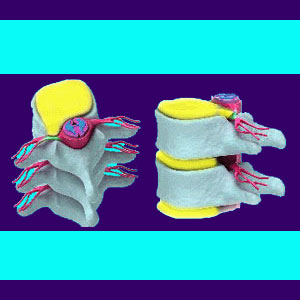
There are many potential causes of sciatica found in the spine, in the lower body musculature, in the sacroiliac joint and even in the recesses of the subconscious mind. Sciatica is one of the most prevalent lower back pain syndromes affecting untold numbers of patients around the world. Sciatica is also one of the most fearsome back pain complaints, due to its reputation as a very stubborn and enduring symptomatic expression. Sciatica was the bane of my existence for much of my young adult life. I still have no definitive physical explanation for my suffering, despite a variety of spinal abnormalities and evaluations from dozens of doctors and chiropractors over the years.
This investigation seeks to provide answers as to the true sciatica causes in the spine, as well as possible sources of pseudosciatica that exist outside of the spinal anatomy.
Anatomical Causes of Sciatica
The vast majority of sciatica complaints are diagnosed as coming from a source in the lumbar spine. The spinal conditions which are implicated in causing symptoms range from bulging discs to arthritic osteophytes, from scoliosis to spondylolisthesis, and from degenerative disc disease to facet joint syndrome.
It is amazing how all these very different structural concerns are often held responsible for causing pain with a very similar symptomatic profile. However, it is still logical, since any of these structural issues can affect the nerve roots which go on to form the sciatic nerve and can therefore create radiculopathy if the nerve tissue is compressed. Sometimes, if no spinal causation exists (very rare), or if treatment for a previously diagnosed spinal causation fails (extremely common), the sciatic nerve pain might be blamed on another structural source.
Sacroiliac pain is a common diagnosis, as is piriformis syndrome. Both of these conditions are quite rare, although the growing incidence of diagnosis would have most patients believing otherwise. It should be noted that technically, if symptoms exist from a non-spinal source, the actual name for the symptomatic syndrome should be pseudosciatica, since true sciatica implies a spinal causation.
Mindbody Sciatica Causes
Psychoemotional back pain typically involves the sciatic nerve through the process of regional ischemia. This often creates the usual pattern of severe lower back ache, with radiating pain, tingling, numbness or weakness in the legs and maybe even feet. Oxygen deprivation back pain can be the very rare result of some anatomical issue, but is far more usually the direct result of a subconscious defense mechanism designed to distract the sufferer from repressed sensitive emotional issues.
Medical science typically does not diagnose or treat psychosomatic pain, since it is ill equipped to recognize, resolve or even understand the symptoms or the reasons why they exist. Although the idea of psychosomatic pain seems far fetched to some people, the treatment, knowledge therapy, has proven itself to be highly effectual, even in patients who were previously convinced that they suffered from structural pain (myself included).
The sciatic nerve has been referred to as an emotional barometer by doctors and philosophers for millenia. It should be no surprise that sciatica symptoms are some of the most common mindbody patient complaints.
Many, Many Possible Causes of Sciatica
Sciatica pain should resolve with appropriate medical care, if not completely on its own. Chronic sciatica is rarely never the result of a known structural concern, despite a diagnosis saying otherwise.
Patients may instead have other undiagnosed anatomical concerns at the heart of their pain. They may suffer from an undiscovered disease process or have endured nerve damage from injury or surgery. They may also simply have normal mindbody pain which has chosen to target one of its favorite targets…. the sciatic nerve.
For patients with relentless pain (years or decades), I sincerely advise reconsidering the diagnosis and thinking about the pain from a completely different angle. A paradigm shift in thought can enact a cure for even the most stubborn pain patterns. This I know for a fact, since my 18 years of chronic misery were solved in a matter of weeks, once I found the right approach to treatment.




